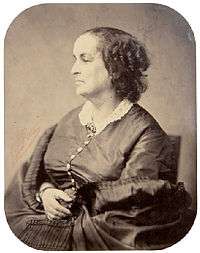Adèle Foucher
Adèle Foucher (27 September 1803 – 27 August 1868) was the wife of French writer Victor Hugo, with whom she was acquainted from childhood. Her affair with the critic Charles-Augustin Sainte-Beuve became the raw material for Sainte-Beuve's 1834 novel, Volupté.[1] Adèle wrote a biography of her husband, published in 1863.

Early life
Adèle Foucher was born in Paris, the daughter of Pierre Foucher, a friend of Victor Hugo's parents. Adèle's brother, Paul Foucher, assisted Hugo by posing as the author of Hugo's play Amy Robsart, which was never published.[2] Paul later produced a successful stage adaptation of Hugo's novel Notre-Dame de Paris.
During their courtship, Hugo wrote about 200 love letters to Adèle, most of which have been published.[3] The couple married in a Catholic ceremony on 12 October 1822.[4] Victor's brother, Eugène Hugo, also loved Adèle, and had a mental breakdown when she married Victor.[5]
Adèle and Victor's first child, Léopold, was born in 1823, but died in infancy. Next came a daughter, Léopoldine, born in 1824. Léopoldine's death in 1843, shortly after her marriage, would cause great distress to her parents, and inspired many of her father's poems, especially those in Contemplations.[6]
Another son, Charles, was born in 1826, followed by François-Victor in 1828, and another daughter, Adèle Hugo, in 1830. By this time Hugo had made his reputation as a poet and novelist. It was shortly after her youngest child's birth that Adèle ceased to have sexual relations with her husband.[7] She then began her affair with Hugo's friend Sainte-Beuve, which lasted until around 1837.[8]

Later life
In 1833, Victor Hugo had become involved with Juliette Drouet, who would become his long-term mistress. In response, Adèle gradually ended her relationship with Sainte-Beuve.[9] Although he did consider leaving Adèle at one point, they remained married, and in later life, when living on the island of Guernsey, a kind of friendship grew up between the wife and the mistress.[10]
After a period of political activity in the 1840s, Victor Hugo fell foul of France's new leader, Napoleon III, and he left the country, going first to Brussels and then to the island of Jersey. In October 1855, he found a permanent home at Hauteville House in St Peter Port, Guernsey,[11] and brought his family to live there with him. While living in Brussels, Adèle bought a greyhound, which after death was stuffed and preserved as an exhibit.[12]
Adèle's biography of her husband, Victor Hugo raconté par un témoin de sa vie, was published in 1863, and was notable for excluding any mention of Victor's sexual adventures.[13]
Adèle died of a "cerebral congestion" at the age of 64, while staying in Brussels, and was buried at Villequier, near the grave of her daughter Léopoldine; her sons accompanied the body on its journey for burial.[14]
References
- Rosemary Lloyd (1996). Revolutions in Writing: Readings in Nineteenth-century French Prose. Indiana University Press. p. 24. ISBN 0-253-33054-8.
- Alfred Barbou (July 2001). Victor Hugo and His Times. The Minerva Group, Inc. p. 120. ISBN 978-0-89875-478-0.
- Henry Mills Alden; Frederick Lewis Allen; Lee Foster Hartman (1901). Harper's Magazine. Harper's Magazine Foundation. p. 162.
- https://books.google.com/books?id=v1rMAgAAQBAJ&pg=PA31&lpg=PA31&dq=leopoldine+hugo+catholic&source=bl&ots=ZBlL0rkqKY&sig=ACfU3U0ops1OYhkblZsltB9XErBYP4T-fA&hl=en&sa=X&ved=2ahUKEwiR5aK4z_nkAhVKTt8KHSaYApsQ6AEwFXoECAsQAQ#v=onepage&q=leopoldine%20hugo%20catholic&f=false
- John Andrew Frey (1999). A Victor Hugo Encyclopedia. Greenwood Publishing Group. p. 137. ISBN 978-0-313-29896-7.
- Victor Hugo (2002). Selected Poetry. Psychology Press. p. 280. ISBN 978-0-415-94076-4.
- Kathryn M. Grossman (1986). The Early Novels of Victor Hugo: Towards a Poetics of Harmony. Librairie Droz. p. 160. ISBN 978-2-600-03622-1.
- Leslie Smith Dow (1993). Adele Hugo. Goose Lane. p. 26. ISBN 978-0-86492-168-0.
- Anne-Martin Fugier, Victor Hugo : la face cachée du grand homme, Secrets d'histoire on France 2 (television), 10 July 2012.
- Louis Guimbaud; Juliette Drouet (2012). Juliette Drouet's Love-Letters to Victor Hugo : Edited with a Biography of Juliette Drouet. Stanley Paul & Co. p. 87. GGKEY:25J2X22WTG3.
- Anna Mah (May 4, 2012). "Where Victor Hugo found freedom". New York Times. Retrieved 9 March 2019.
- Alfred Barbou (July 2001). Victor Hugo and His Times. The Minerva Group, Inc. p. 311. ISBN 978-0-89875-478-0.
- John Andrew Frey (1999). A Victor Hugo Encyclopedia. Greenwood Publishing Group. p. 109. ISBN 978-0-313-29896-7.
- Andrew Haggard (1923). Victor Hugo: His Work and Love. Hutchinson & Company. p. 256.